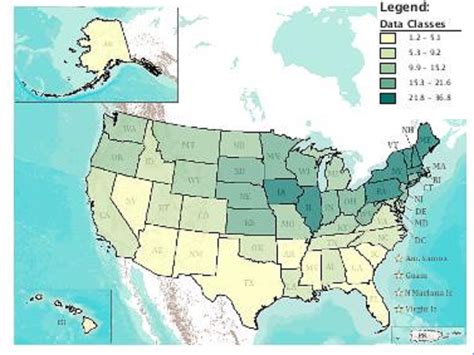Overview: Demystifying the Census
In the realm of AP Human Geography, the census holds immense significance as a crucial tool for understanding population dynamics and socio-economic characteristics of societies. It serves as an essential data source for researchers, policymakers, and individuals alike.

The term “census” refers to the systematic process of collecting, compiling, and analyzing information about a population. It typically involves gathering data on demographic variables such as age, sex, ethnicity, and household composition, as well as socio-economic indicators like income, education, and employment.
Why Census Matters
The census provides invaluable insights into the current and future state of populations. Its data is used for a wide range of purposes, including:
- Population Planning: Governments rely on census data to allocate resources such as healthcare, education, and infrastructure based on the needs of different population groups.
- Policy Formulation: Policymakers utilize census data to develop policies that address specific challenges and opportunities identified in the population.
- Research and Analysis: Researchers employ census data to study a variety of social, economic, and demographic trends, contributing to our understanding of human behavior and societal changes.
- Demographic Projections: Census data enables experts to project future population growth, age distribution, and other demographic characteristics.
- Business Decision-Making: Businesses use census data to identify market opportunities, target specific customer segments, and assess labor market trends.
Types of Census
There are two primary types of census conducted by governments:
- De Jure Census: Counts individuals based on their legal residence or usual place of abode.
- De Facto Census: Counts individuals based on their physical presence in a given area at a specific point in time.
In addition to these two main types, censuses can also be classified based on their frequency (e.g., annual, decennial) and scope (e.g., national, local).
The US Census: A Case Study
The United States Census Bureau conducts the decennial census every ten years, with the most recent one occurring in 2020. The census collects a vast amount of data on the American population, including:
| Demographic Variable | Socio-economic Variable |
|---|---|
| Age | Income |
| Sex | Education |
| Race | Employment |
| Hispanic or Latino Origin | Housing |
| Ancestry | Poverty Level |
The US Census is widely recognized for its accuracy and comprehensiveness, making it a valuable resource for policymakers, researchers, and the general public.
Applications Beyond Traditional Uses
While census data is primarily used for population analysis, it can also be leveraged for a range of innovative applications:
Spatial Planning: By overlaying census data with geographic information systems (GIS), planners can identify areas with specific demographic or socio-economic characteristics, helping them make informed decisions about land use and development.
Precision Marketing: Businesses can use census data to segment their target audience based on specific demographic and socio-economic criteria, resulting in more effective marketing campaigns.
災害 preparedness: Census data can assist emergency planners in identifying vulnerable populations and allocating resources accordingly in the event of natural disasters or other emergencies.
Mobility Studies: By tracking changes in population over time, census data can provide insights into migration patterns and the dynamics of urban and rural areas.
Tips and Tricks for Using Census Data
- Define Your Research Question: Clearly identify the specific question you are trying to answer with census data.
- Select the Appropriate Census: Choose the census that best aligns with the time period and geographic scope of your research.
- Explore the Data: Familiarize yourself with the available census variables and documentation before analyzing the data.
- Use Data Manipulation Tools: Utilize statistical software or online tools to manipulate and visualize census data effectively.
- Consider Data Quality: Assess the accuracy and reliability of census data before drawing any conclusions.
Common Mistakes to Avoid
- Using Incomplete Data: Ensure that you are utilizing a full and up-to-date census dataset.
- Misinterpreting Data: Carefully review the documentation and variable descriptions to avoid misinterpreting the data.
- Making Unwarranted Generalizations: Census data represents a snapshot of a population at a specific point in time. Avoid making generalizations about entire populations based on a single census.
- Ignoring Context: Consider the historical and social context of the census data to avoid drawing erroneous conclusions.
Frequently Asked Questions
-
What is the difference between a census and a survey?
A census collects data from the entire population within a defined area, while a survey collects data from a representative sample of the population. -
How often should a census be conducted?
The frequency of census varies depending on the country and its resources, but most developed countries conduct a census every 5-10 years. -
What are the challenges associated with conducting a census?
Challenges include ensuring complete coverage, minimizing undercounting, and addressing privacy concerns. -
How can I access census data?
Most countries provide access to census data through their national statistical offices or online databases. -
What is the “Enumeration Area” in a census?
An Enumeration Area is a small geographic unit defined for the purpose of conducting the census. -
What is the “Household” in a census?
A Household is defined as a group of people living together and sharing the same basic necessities. -
What is the “Dwelling Unit” in a census?
A Dwelling Unit is defined as a structure suitable for habitation, regardless of whether it is occupied. -
What is the “Economic Activity Status” in a census?
Economic Activity Status refers to the employment or unemployment status of an individual.
Conclusion
The census serves as an indispensable tool for understanding and analyzing population dynamics. Through the systematic collection and analysis of demographic and socio-economic data, the census provides a wealth of information that informs decision-making, research, and a wide range of applications. By embracing the power of census data and leveraging it effectively, we can gain valuable insights into the human experience and shape a better future for all.
